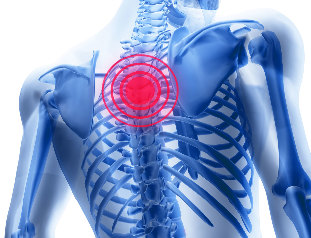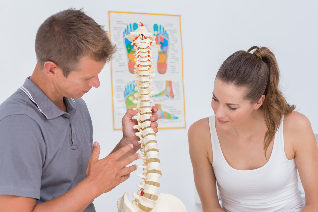Thoracic osteochondrosis is a chronic disease, which is based on the degenerative-dystrophic lesions of the intervertebral cartilaginous disks, which leads to reactive changes in the vertebral bodies and surrounding soft tissues. The disease is widespread and affects mainly people of working age (25-45 years).
Thoracic osteochondrosis is found much less frequently than lumbar or cervical. This is because this region of the spine have less static and motor load than others. However, osteochondrosis of the thoracic spine is much more difficult to diagnose, as it in most cases occurs, simulating disease of the lungs, heart, organs of the upper parts of the digestive system.

Causes and risk factors
Currently the exact causes of thoracic degenerative disc disease is not established. Experts proposed many theories (infectious-allergic, genetic, mechanical, hormonal, vascular), but none of them gives a clear and complete explanation of the pathological changes that occur in the spine and lead to degeneration of tissues. Most likely, in the pathological mechanism of the development of thoracic osteochondrosis at the same time involved several different factors. But the main value belongs to the long overloads static-dynamic vertebral segment.
Factors that cause such overload are:
- anomalies in the structure of the spine;
- asymmetrical arrangement of joint cracks in the intervertebral joints;
- congenital narrowing of the spinal canal;
- spondylogenic muscular (myofascial, mirrored) and/or somatic (reflected, which arise on the background of a number of diseases of the blood vessels and internal organs) pain;
- prolonged exposure to the spine vibration, for example, the drivers of motor vehicles;
- physical stress;
- obesity;
- Smoking;
- sedentary lifestyle (lack of exercise);
- psychosocial factors.
The mobility of the spine is provided by the intervertebral discs, which also play a cushioning role. In their center there is an elastic nucleus pulposus, which in large quantities is water. Osteochondrosis nucleus begins to lose water as a result of demineralization of the polysaccharides. Over time, the nucleus is flattened, and with it, he flattens and the intervertebral disc. Under the influence of mechanical loading of the fibrous ring bulges, a process called protrusion. Later in the drive cracks through which to fall out fragments of nucleus pulposus, i.e., the formation of the herniated disc.

Reduction of disc height leads to a convergence of neighboring vertebrae, disorders of the anatomy of the facet joints. All of this triggers a reactive inflammation in the facet joints and surrounding soft tissues. In addition, the convergence of the vertebral body accompanied by stretching of the articular capsules, and the affected segment of the spine becomes unstable. The vertebral bodies receive excessive mobility, which can cause the infringement of spinal nerve roots and the development of radicular syndrome.
On the background of osteochondrosis of the thoracic gradually growing bone tissue of the vertebral bodies forms the bony growths (osteophytes). They can also cause radicular compression syndrome or myelopathy (spinal cord compression).
Classification
The classification of thoracic osteochondrosis lies posindromnoy principle. Depending on which nerve structures affected structures of the spine have an impact, identify the following syndromes:
- compression – the basis for its development lies the tension, the deformation or compression of the nerve root, part of spinal cord or blood vessel, depending on what develops spinal, vascular or radicular syndromes;
- reflex – is associated with reflex tension of innervated muscles, degenerative and vascular disorders;
- bioadaptive.
Symptoms of thoracic degenerative disc disease
The main symptom of thoracic degenerative disc disease is pain. In most cases it is a dull modest.
Prolonged stimulation of spinal roots causes innervation of the internal organs. Depending on the level of the lesion, thoracic osteochondrosis can occur under the guise of somatic diseases.
| The level of the lesion | Innervated organs | Clinical symptoms |
| C7-Th1 | The hand, wrist, hands, trachea, esophagus | Pain in the arms and hands, asthma |
| Th2-Th3 | Heart, pericardium, coronary arteries | Coronary heart disease, arrhythmia |
| Th4-Th5 | Bronchi, lungs, pleura, mammary glands, nipples | Bronchitis, pneumonia, pleurisy>[!@#$], bronchial asthma |
| Th5-Th6 | The common bile duct, the gallbladder | Cholelithiasis, violation of process of digestion of fats |
| Th6-Th7 | Liver, solar plexus | Disorders of the liver |
| Th7-Th8 | Stomach | Dyspepsia, gastritis, gastric ulcer and duodenal ulcer |
| Th8-Th9 | Duodenum, pancreas | Digestion and chair, duodenitis, pancreatitis |
| Th9-Th10 | Spleen, diaphragm | Hiccup, respiratory disorders |
| Th10-Th11 | The adrenal glands | Allergic reactions, decreased immunity |
| Th11-Th12 | Kidney | Pyelonephritis, urolithiasis |
| Th12-L1 | The kidneys and ureters | Voiding |
In this regard, the most common symptoms of thoracic osteochondrosis are:
- pain in the chest (behind the sternum, at the side, back, in the intercostal space) – can be both acute and aching, dull; often radiating in the arm;
- pain in the epigastric region – arise regardless of the nature of power, characteristics of the diet; often combined with heartburn, nausea, vomiting;
- pain in the right upper quadrant – increase by changing the position of the patient's body, sneezing, cough;
- pain in the lumbar region – simulate an attack of renal colic, often associated with dysuric disorders.

For compression of the nerve root in a patient with thoracic osteochondrosis develops an attack of intercostal neuralgia. It is characterized by the occurrence of acute pain in one side of the chest (thoracalgia). Pain are surrounding the character and disseminated in the course of one of the intercostal nerves from the spine to the sternum. Patients describe them as "electric shock" or "cross". The pain may radiate to the region of the epigastrium, retrosternal region, shoulder, arm, and combined with some other symptoms (local hyperhidrosis, pallor or flushing of the skin) associated with a lesion of the sympathetic fibers of intercostal nerve.
For intercostal neuralgia characteristic paroxysms of pain, lasting from several seconds to several minutes. During the attack the pain becomes unbearable. Trying to somehow alleviate their condition, patients freeze in a certain position of the body, avoiding deep breaths, coughing, sneezing, turns.
Out of pain attack in the patients observed paresthesia (subjective violations of skin sensitivity in the form of pins and needles, tickling, pricking with needles) in the course of the intercostal space.
Diagnosis
Diagnosis of thoracic osteochondrosis is conducted on the basis of the data of objective examination of the patient, laboratory and instrumental examination, which includes:
- General blood count (mild leukocytosis, increased ESR);
- the serum electrolytes (reduced calcium levels);
- urinalysis;
- biochemical analysis of blood;
- x-ray examination of the thoracic spine (manifested housing of the intervertebral disc, the deformation of the end plates of the adjacent vertebral bodies, the displacement of the adjacent vertebral bodies relative to each other);
- scintigraphy of the spine (detects a process of active bone mineralization of the vertebral bodies);
- myelography;
- computer and magnetic resonance tomography.
Breast low back pain requires a differential diagnosis with the following diseases and pathological conditions:
- dishormonal spondylopathy;
- spondylolisthesis;
- inflammation;
- ankylosing spondylitis;
- osteomyelitis of the spine;
- rheumatoid arthritis;
- neoplastic processes (metastatic or primary tumors of the chest);
- fractures of the spine;
- diseases of the gastrointestinal tract (chronic pancreatitis, peptic ulcer and duodenal ulcer, diverticulitis, irritable bowel syndrome);
- diseases of the genitourinary system (urolithiasis, pyelonephritis);
- cardiovascular disease (ischemic heart disease, arrhythmia).

Treatment of thoracic osteochondrosis
Treatment of thoracic osteochondrosis is conducted in ambulatory conditions. When expressed pain syndrome patient for 2-3 days bed rest is prescribed. Shown traction of the affected segment of the spine, which helps to eliminate compression of the nerve root and thereby stop pain. When expressed pain syndrome carried out infiltration of the soft tissues 2% solution of novocaine. A short course can be assigned a non-steroidal anti-inflammatory drugs.
In the scheme of complex treatment of thoracic osteochondrosis are also included:
- antihistamines;
- b vitamins;
- tranquilizers;
- acupuncture;
- massage;
- manual therapy.
After improvement the patient was sent to physical therapy sessions. Regular performance of physical exercise in breast osteochondrosis promotes the formation of a well-developed muscular system, which allows to keep the spine in the correct physiological position, eliminates excessive static loads.
Of great importance in the treatment of thoracic osteochondrosis is given regular moderate exercise (swimming, yoga, tai Chi), normalization of body weight. Jumping, running, weightlifting and other sports, which are accompanied by increased loads on the spine, is contraindicated.
Surgical treatment of thoracic osteochondrosis are shown only if significant spinal cord compression. In such cases, depending on the readings do the following:
- stabilization of the spinal segment;
- replacement of the affected disk artificial implant;
- laser reconstruction of the disk;
- puncture vaporization of the affected disk;
- a microdiscectomy.
Possible consequences and complications
Prolonged irritation or compression of the nerve roots can trigger the development of somatic diseases of the chest, upper part of the alimentary system, kidneys. The greatest danger thoracic osteochondrosis is for the myocardium.
Also the effects of thoracic degenerative disc disease can be a disease of the esophagus, stomach, duodenum, pancreas, gall bladder, lungs, and the formation of intervertebral hernia.
Forecast
Thoracic osteochondrosis is characterized by undulating course in which remission are accompanied by exacerbations. Timely begun treatment, the patient's compliance with all recommendations of the doctor concerning both the treatment of the disease and the lifestyle changes, the prognosis is favorable.
Prevention
Prevention breast osteoarthritis includes:
- normalization of body weight;
- Smoking cessation;
- active way of life.
































